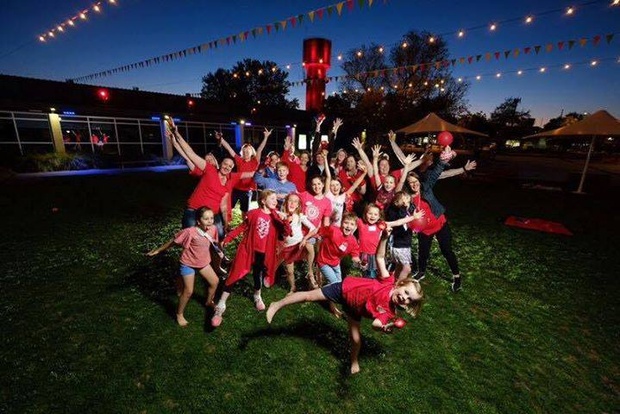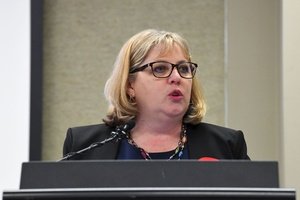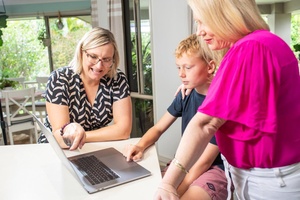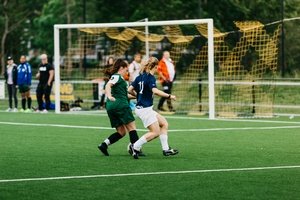Eventually, she found him hiding in a cupboard, swathed in a blanket.
“[He was] saying, 'I'm dumb, I'm stupid',” the primary learning and support teacher from New South Wales says.
Despite his incredible vocabulary and ability to articulate himself verbally, Mavlian says when it came to learning to read at school, her son's dyslexia battle took on many fronts.
"I was told, ‘He's a boy, it will click, it takes longer. Don't worry, it will happen’. But it didn't happen – [I] found a ‘wait to fail model’ was very alive and well.”
The teacher "tried everything" that she had learned in her own ITE degree, but to no avail.
“I was giving him more intensity of [those approaches], but more intensity of the wrong medicine is the wrong medicine – it’s not going to help. I needed to look for something more.”
It was then that Mavlian discovered the science of reading. She hasn’t looked back.
“I'm saying, ‘Well, why didn't I know this? Why wasn't this in my undergrad degree?’
“I did a lot of self-education, but I also did a master's degree in special ed. The stuff that we did in the reading component for that really should be in every teacher's undergrad degree; it’s basic knowledge of how to teach reading.”
Mavlian says she is not alone in this experience.
In light of Dyslexia Awareness Month, Code Read Dyslexia Network – a national volunteer-run charity that started in 2015 – is calling on Australians to illuminate significant monuments, buildings and landmarks across the country in red – the colour signifying the urgency of action needed.
Mavlian, a founding member of the network, says although there have been some positive signs signalling a broader shift towards the science of reading in education, such as greater emphasis on phonics in the NSW syllabus and the mandating of a Year 1 phonics screening check in multiple states, there is still some way to go.
Early intervention is one area in need of improvement, she says.
“The earlier you start intervention, the better; you get more bang for your intervention buck, and it doesn't take you as long. The longer you leave it, the longer it takes.
“If you can get in and do early screening for children and know what you're looking for, then their self-esteem doesn't suffer because they're getting what they need.
“They don't start to look around and they can keep up with their peers … they don't have those obvious (learning) gaps that just get wider, and wider, and wider if you don't do anything about it.”

For Code Read, red became the colour symbolising "power and our collective passion for positive change". The network want to "take back ownership of the colour red on behalf of so many dyslexic kids struggling through school, for whom it represented the daily dread of having their workbooks returned, covered by corrections in red ink".
Mavlian references statistics that indicate if a child in Year 1 is struggling with literacy and doesn’t receive proper intervention, by the time Grade 4 hits they will have fallen further behind their classmates. By Year 9, the learning gulf is only “bigger and harder to fix”.
Early intervention also means less behavioural issues down the line, she says.
“Older kids will do one of two things: they'll often hide in the classroom, if they can they'll avoid reading, they'll try and slip under the radar.
“Then we can get more students who will act up. So rather than have to read in the classroom or endure the shame of not being able to access the curriculum because they can't read it, they will muck up.
“And so, you might get boys that or even girls that would much rather be thrown out of the classroom and sent to the principal then endure the shame of not being able to read – it does have an impact on behaviour,” she warns.
Children with dyslexia need to learn to read and write in the same way every other child does, the educator adds.
“Kids with dyslexia don't need anything special. They just need more intensity of the right combination of [instructional focus]’.”
A child’s specific literacy issues – be they with fluency, phonemic awareness, writing or otherwise, must be pin-pointed and addressed, Mavlian says.
“It's not a one size fits all label.”
Dyslexia can present in various ways in the classroom, Mavlian says.
“Some children have really profound problems with what we call the phonological skills and phonemic awareness skills. And then some children have problems with learning the grapheme-phoneme correspondences. [These] can underpin your ability to acquire letter- sound knowledge…”
Something that is rarely tested in schools is Rapid Autonomic Naming (the ability to quickly name aloud a series of pictured items, numbers and letters), the educator says.
“Rapid Automatic Naming skills are really underutilised as a screening tool."
Parents’ advocacy work has proven crucial in the charge to share the science of reading across the country, Mavlian says.
Online support groups run by parents have been campaigning for policy change, with Dyslexia Victoria Support this year successfully bringing about shifts in policy and practice within the state education department.
Code Read sprung from a group of proactive mums who, tired of advocating in isolation for their children, united via online dyslexia support groups to enact change.
“I think it's been really important that parents are actually going into schools and saying, ‘Well, how about phonological awareness and looking at this?’ And [some schools] are like, ‘What?'" Mavlian says.
“You don't know what you don't know. And you think (as a teacher) you’re doing a great job. And I thought I was doing a great job until I crashed into my own son…”
Samantha Hornery, a learning disabilities specialist with not-for-profit organisation Learning Links Australia, says although we’re now all ‘talking from the same hymn book’ when it comes to the wide acceptance of phonics as a key pillar in early reading instruction, it’s often the case that interventions for students with dyslexia are cut short and/or don’t have enough focus on building phonemic and phonological skills.
“When conducting an additional intervention for students with dyslexia, you need a couple of times a week, for a couple of months, until you're starting to see that progress.
“But more importantly, in the case of students with dyslexia, time is really their enemy – it takes them a little bit longer to see that progress. And so, it's about remaining with that intervention for as long as they require. And it's not a sexy answer, but it's actually the true answer,” Hornery tells EducationHQ.
“And often, it's just that [the intervention] hasn't gone long enough for those improvements to really stick [into] high school.”

Samantha Hornery says she tutors teenagers who bear the "legacy" of failed literacy interventions.
Hornery is gearing up to present at the Dyslexia Learning Festival on October 19, where she plans to zero in on how common phonics resources can be converted for use with teenagers experiencing literacy difficulties.
“What do you do for those kids when all the phonics resources look like they are suitable for Kindergarten? How do we provide that support for them when everything looks to be [for young children]?” she asks.
The educator says she sees the consequences for those children in primary school who ‘desperately’ want to be learning and participating in class, but whom struggle to crack the code of reading without extra help.
“Particularly in my tutoring work, I see students right up until Year 12, and I see the legacy of [that] early reading failure – it takes them so long to read things that they have a dislike of reading – you just can't get through school if you can't read.”
Mavlian says it’s not acceptable that so many children continue to graduate from secondary schools without the literacy skills they need to really succeed in life.
“Help shouldn't be dependent on a diagnosis,” she says.
“At the school that I work at the moment, it’s in a very underprivileged area and I know our parents a can't fork out for additional tutoring outside of school – and they shouldn't have to.
“Good, solid instruction should be done at school to begin with, you shouldn't go to school for 13 years and come out without being able to read at an appropriate level.
“And 50,000 kids in Australia each year come out of school [without] the literacy skills that they need to be able to function in society.
“They're terrible statistics, and you look around a football stadium, and it's a football stadium full of children every year that leave school with insufficient literacy skills.”














